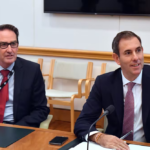Is Australia’s infrastructure overrun by the ‘population ponzi’?
Infrastructure in our major cities is at or over capacity. William Bourke claims that this is a politically engineered crisis Australia needs to address by lowering immigration rates.
NAB Chairman Ken Henry recently stated that Australia’s population is expected to grow by an astonishing 400,000 people every year, and added:
“My observation in Sydney, in Melbourne, today is that people already think – with very good reason – that the ratio of population to infrastructure is too high.
“Australia will need to construct a new city every year as big as Canberra or Newcastle to accommodate the expanding number of people, he said. Or, every 5 years, Australia would need to build an entire new city from scratch for 2 million people; or an entire new city as big as Melbourne every decade.
“Without such action, there will be more congestion, longer commute times to work and increasing problems with housing affordability…”
With our news and political discourse often dominated by more trivial issues, it’s important for us to keep these big public policy priorities in mind and ask: Why is the government not providing the infrastructure necessary to maintain our economic productivity and living standards?
Infrastructure underpins our economy. Recent Government budget papers state that:
“Congestion imposes a real and substantial economic and social cost on our communities. These costs include longer travel times, higher greenhouse gas emissions, higher vehicle operating costs and road trauma. The avoidable cost of congestion is estimated to rise to around $20 billion per year by 2020.”
This is a key reason for various Liberal and Labor governments endorsing increasing debt and deficit, and the sell-off of our public assets in order to fund all sorts of mega infrastructure projects. But can complex retro-fitting of infrastructure to our already built-up cities be a viable solution?
Despite the claims of urban infill advocates like the Greens party, much of our major city infrastructure – built rightly or wrongly for lower density – is now at or over capacity. You only need to read the latest reports about overcrowded roads, trains, buses, schools and hospitals to know this.
So rather than chasing our tail, we need to get to the bottom of one simple question: What is causing the infrastructure malaise?
The increasingly obvious reason is that Australia’s rapid population growth has resulted in our cities reaching diseconomies of scale. Diseconomies of scale are the forces that cause governments or business to produce goods and services at increased per-unit costs, like roads, train lines, water, recreational areas, hospitals and schools.
As Macro Business economist Leith van Onselen puts it:
“In already built-up cities like Sydney and Melbourne, which also happen to be the major magnets for new migrants, the cost of retrofitting new infrastructure to accommodate greater population densities can become prohibitively expensive because of the need for land buy-backs, tunnelling, as well as disruptions to existing infrastructure.
“We have seen these diseconomies of scale time and time again. For example, projects like Melbourne’s now defunct East West Road Link was expected to cost 18 billion, whereas Sydney’s North West Rail Link would cost $8 billion. That’s an astounding $350 million to $1 billion per kilometre.
“Hence, running a high immigration program becomes increasingly costly for existing residents. The huge infrastructure costs also force unpopular asset sales, increased debt borrowings and austerity – none of which is a desirable outcome.”
A Grattan Institute report entitled ‘Budget pressures on Australian governments’ adds weight to this analysis. It found that unprecedented infrastructure spending by states and territories is largely responsible for a $106 billion decline in their finances since 2006. The Grattan report shows that state and territory borrowing for capital expenditure over the last seven years drove their finances backwards from $37 billion in the black in 2006 to $69bn in debt in 2013. So the new infrastructure is not only unaffordable, it’s sending us deeper and deeper into debt. Salt is added to taxpayer wounds when we hear that expensive new road projects are predicted to be gridlocked within a decade.
Not only does urban infill overrun our infrastructure, it also reduces critical biodiversity and green space. As an example of this, Stonnington Council in Melbourne is considering buying back properties to create more parks and open space in its densified suburbs, at taxpayer expense.
Put simply, growth in our particular cities has become uneconomic, and as a by-product, our international competitiveness is suffering. We are diverting more scarce economic capital into costly city-building infrastructure and high-rise apartments rather than investing in critical tradeable sectors like manufacturing and agribusiness; not to mention small business entrepreneurship.
Driving all of this is what’s now known as the ‘population ponzi’ – the politically engineered underpinning of housing with ever more demand (mainly via high immigration, foreign buyers and investor tax concessions). This of course provides banks with more mortgage customers.
It’s no coincidence therefore that banks like the NAB demand taxpayer funding for mega infrastructure – effectively subsidies for property developers and the banks that finance them – rather than addressing the root cause of demand growth.
As the first step in securing an economically, environmentally and socially sustainable Australia, it’s time to lower annual permanent immigration from a record high of over 200,000 per year, back to the long term average of around 70,000 per year.
The immigration program must be run in the public interest, not just in the interests of the powerful few at the top of the wealth pile. In the end, even the wealthy elites and their children will be hurt by the direct impacts of high immigration on wage depression and skyrocketing house prices. As disposable income is squeezed, the whole economy slowly but surely grinds to a halt.
For the common good, including housing affordability, it’s time to deflate the population ponzi.
DISCLAIMER: Open Forum aims to encourage vibrant discussions amongst Australians of all backgrounds and beliefs about the important issues affecting our communities. We don’t endorse any particular view expressed in the blogs we publish – we merely provide a platform for exchanging ideas and opinions. It is to be expected that individual users of this site will sometimes disagree with one another, and we invite you to join the debate by commenting on this or any of the published blogs.

William Bourke founded Sustainable Australia in 2010. It is a centrist political party which campaigns for secure jobs, affordable housing, better planning, and a sustainable environment and population for Australia.














Tabitha
February 28, 2017 at 9:10 am
Is Australia’s infrastructure overrun by the ‘population ponzi’?
Great article. In the short period since 2000 when Australia's population was 19m, it has grown over 20%, to 24 million. We've added another Melbourne, but not the necessary infrastructure! Who gave the Liberal Labor and Greens parties a mandate to triple immigration from the long term twentieth century average of 70,000 per annum? Nobody. Yet the only political party willing to address this is Sustainable Australia. Hopefully people will remember this at the ballot box.